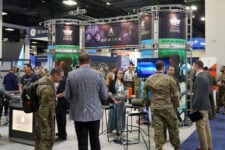 Just over a century ago, America faced two crises simultaneously. The first unfolded as our troops clashed with adversaries in the World War I. Then a new enemy appeared—the 1918 influenza pandemic. While this virus killed tens of thousands of Americans and threatened the readiness of the U.S. military, our leaders understood they could not shift their focus solely to this new threat. Instead, they worked to address the health crisis while also providing the necessary resources for the crisis on the battlefield, which included support for the defense industrial base that was crucial to its success on the battlefield. The leaders understood these were not competing demands; both were closely connected to America’s vitality.
Just over a century ago, America faced two crises simultaneously. The first unfolded as our troops clashed with adversaries in the World War I. Then a new enemy appeared—the 1918 influenza pandemic. While this virus killed tens of thousands of Americans and threatened the readiness of the U.S. military, our leaders understood they could not shift their focus solely to this new threat. Instead, they worked to address the health crisis while also providing the necessary resources for the crisis on the battlefield, which included support for the defense industrial base that was crucial to its success on the battlefield. The leaders understood these were not competing demands; both were closely connected to America’s vitality.
Today, we find ourselves in an eerily similar situation. America is working to overcome COVID-19, while the U.S. military continues to respond to and prepare for the many and evolving threats around the world.

Eric Fanning
Once again, we find ourselves at an important inflection point, one that requires an appreciation for the extraordinary demands placed not only on our citizens and economy during this crisis, but also on our troops and national security. As they did in 1918, our leaders must today acknowledge we cannot ignore our national security needs—needs already undermined by this health crisis—while this latest pandemic is addressed. Bold leadership is necessary to put politics aside and provide stable and sufficient federal investment in national security even while other crisis legislation is being debated. The good news is there is an ideal and immediate opportunity to do just that: the House and Senate can follow regular legislative order, pass the annual defense authorization and appropriations bills, and send both to the president’s desk for his signature as soon as possible.
Time is of the essence since government funding will soon run out, the COVID-19 crisis is continuing, and elections loom. New missions for our troops, new threats to our security, and new challenges to the supply chain are underway.
As is often the case, America’s military personnel are asked to take on new missions: this time in responding to the pandemic. Servicemembers rose to the challenge and moved out quickly to assist with the public health response, delivering medical supplies, assisting with widespread testing and helping to treat patients. Currently, the Pentagon is also helping lead Operation Warp Speed, whose mission is to help speed the development, manufacturing and delivery of COVID-19 vaccines.
Meanwhile, security threats are not receding – they are multiplying and growing in complexity. Last month, China’s navy fired two so-called ‘carrier killer’ missiles into the South China Sea, weapons designed to close international sea lanes and ensure Chinese dominance in that vital region. Leadership change in North Korea—and its continued threat to build nuclear capabilities—present further risks in the Asia-Pacific region. Russia has stated its willingness to intervene if the political crisis in Belarus continues to deteriorate. In the Middle East, Iran attacked a military base earlier this year and remains a destabilizing force, exporting terror and continuing to pursue a path toward nuclear weapons capability. And many of these adversaries have also demonstrated some cyber space and counterspace weapon systems capabilities that pose a threat to our military and economic systems.
New risks to the strength of America’s defense industrial base are also a major challenge to our security. Our armed forces are the first line of defense against these threats, but they depend on a broad and vibrant industrial base and its unique workforce to support them.
To ensure sustained support for our national security customers, essential work has continued throughout the crisis, with thousands of employees from industrial base and supply chain businesses on the job—their commitment to their customers’ missions and our country’s security steadfast. Unfortunately, like the rest of the economy, that industrial base and workforce have been buffeted by the health crisis. Supply chains have been damaged by material shortages and transportation disruptions, and the workforce has had to contend with sickness, closed facilities, and changing workplace requirements.
Financial resources are stretched thin for many small and medium-sized businesses, and expenses are piling up. Along with large prime contractors, the thousands of small and mid-sized businesses that make up the bulk of the defense supply chain have incurred significant unexpected expenses—some totaling in the hundreds of thousands of dollars—to help safeguard their employees’ health while they continue to perform their essential duties. Congress recognized the need to support these businesses as they continue their work, including a provision in the CARES Act to authorize reimbursements for costs associated with continued operations during the pandemic. However, supplemental appropriations relief for these and other significant and unanticipated COVID-19 costs are critical to stem further losses in our industry and help keep the industrial base vibrant.
Crisis-related challenges like those above cannot be understated. Long-term strategic challenges must be considered as well. Deterring threats to our national security requires military readiness to ‘fight tonight’ and modernization to outpace our adversaries. A strong and secure industrial base and supply chain are necessary to support both. All three rely on sustained and stable federal investment in national security. Over the last several years, solid progress has been made in improving readiness and modernization, as well as strengthening the supply chain, thanks to bipartisan congressional support for increased investment and cooperation between DOD and industry. It is crucial to maintain that hard-gained progress while also addressing the impacts from the pandemic.
Congress has the tools and time to help provide stable and sufficient funding in national security and do so in the same bipartisan way. Timely enactment of defense policy and funding—through the NDAA and appropriation bills—are great vehicles to do that. As our leaders in 1918 confirmed, we must not make the mistake of ignoring either national security or the health crisis, because America’s recovery and vitality are at stake.
Eric Fanning, a member of the Breaking Defense Board of Contributors, is president and CEO of the Aerospace Industries Association, representing more than 300 companies in the aerospace and defense sector. He served as 22nd Secretary of the Army and Acting Secretary of the Air Force.
House lawmaker hopes to resuscitate DoD’s venture fellowship program
Rep. Elise Stefanik criticized the Air Force’s decision to terminate a fellowship program that paired DoD personnel with the private sector as “shortsighted and misguided,”


























